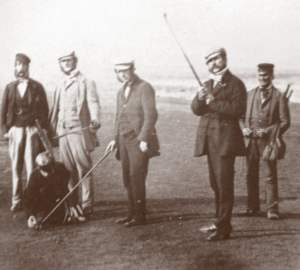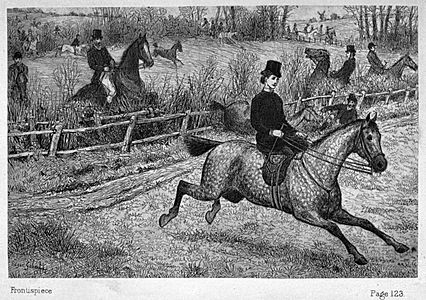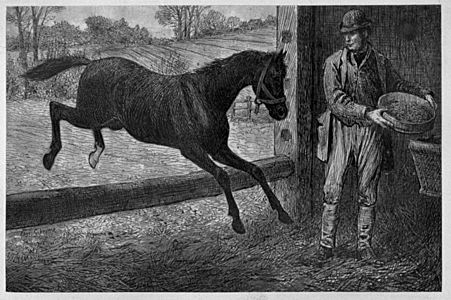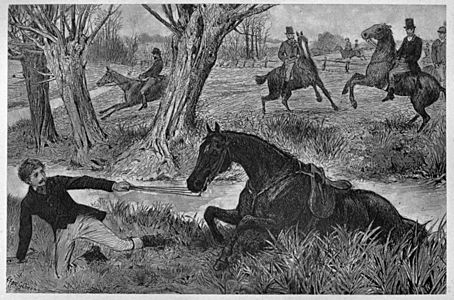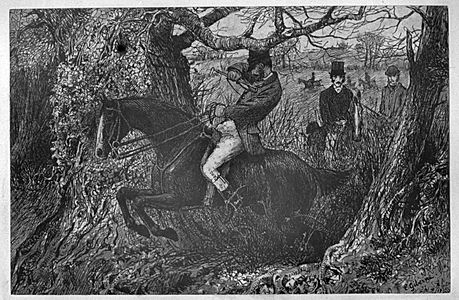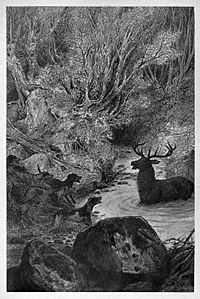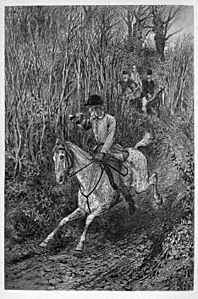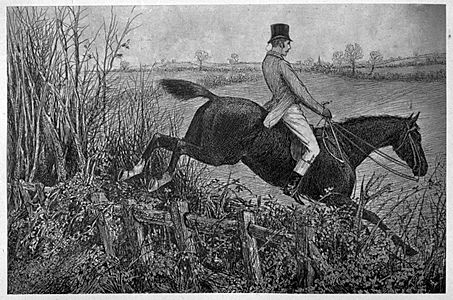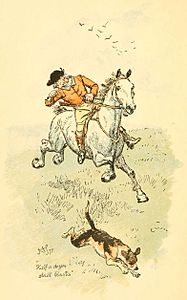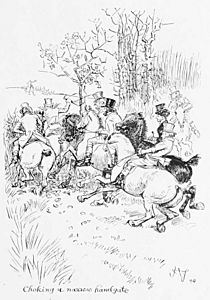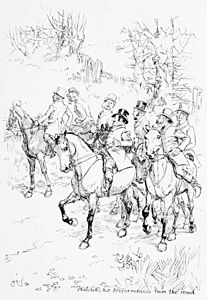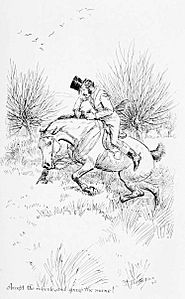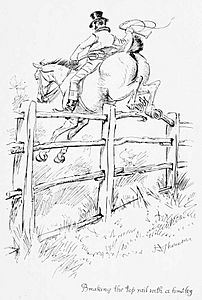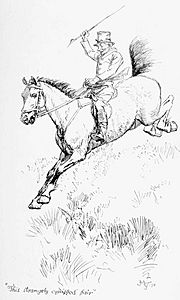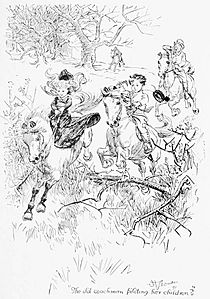George Whyte-Melville facts for kids
Quick facts for kids
George John Whyte-Melville
|
|
|---|---|
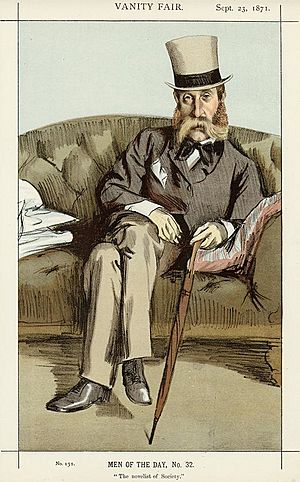
Caricature by James Tissot in Vanity Fair
|
|
| Born | 19 June 1821 Mount Melville, St. Andrews, Scotland
|
| Died | 5 December 1878 (aged 57) Braydon Pond, Charlton, Wiltshire, England
|
| Nationality | Scottish |
| Occupation | Sportsman, soldier, and author |
| Years active | 1851–1878 |
| Known for | Novels with a hunting setting |
|
Notable work
|
Riding Recollections (1878) |
George John Whyte-Melville (born June 19, 1821 – died December 5, 1878) was a Scottish writer and poet. He was very interested in field sports, especially hunting. He also served as a soldier for a short time during the Crimean War. Whyte-Melville became famous for his novels that often featured hunting and adventure.
Contents
Life and Early Career
George John Whyte-Melville was born in 1821 at Mount Melville, near St Andrews, Scotland. His father, Major John Whyte-Melville, was a well-known sportsman and a leader at The Royal and Ancient Golf Club of St Andrews. George's mother was Lady Catherine Anne Sarah Osborne.
George was taught at home by a tutor before going to Eton, a famous school. In 1839, he joined the army as an officer in the 93rd Highlanders. Later, in 1846, he moved to the Coldstream Guards. He left the army in 1849 with the rank of captain.
In 1847, Whyte-Melville married Charlotte Hanbury-Bateman. They had one daughter named Florence Elizabeth.
Becoming a Famous Author
Whyte-Melville started his writing career by translating some works by the ancient Roman poet Horace in 1850. His first novel, Digby Grand, was published in 1852 and was a big hit! After that, he wrote 21 more novels and became a very popular writer, especially for his stories about hunting.
Many of his characters, like Digby Grand and Kate Coventry, were involved in hunting. Some characters even appeared in different novels.
One of his books, Bones and I, or The Skeleton at Home, was quite different from his usual hunting stories. It was about a person living alone in London, looking out at a hospital wall. Whyte-Melville also wrote the words for a famous sad song called "Good-bye!" by Paolo Tosti.
He wrote several historical novels too, with The Gladiators being one of the most famous. Another historical novel, Sarchedon, was set in Ancient Babylon. Besides novels, he published poetry collections like Songs and Verses (1869). However, he is best remembered for his exciting stories about hunting and the society of his time.
Many other writers were inspired by Whyte-Melville. Henry Hawley Smart and Mrs. Lovett Cameron both looked up to him when they started writing sporting novels. He also encouraged Florence Montgomery to publish her children's stories.
A famous line from one of his hunting songs, "Drink, Puppy, Drink," is still remembered today. He also wrote the well-known opening line of a short poem: "To eat, drink, and be merry, because to-morrow we die."
Service in the Crimean War
When the Crimean War began, Whyte-Melville volunteered to serve as a major in the Turkish irregular cavalry. This was the only time he took a break from his busy writing career.
His Death
Sadly, George Whyte-Melville died in 1878 while out hunting with the Vale of White Horse Hunt. He fell from his horse while galloping across a field in Charlton, Wiltshire. It was surprising because he was a very skilled horseman and had often said he had only fallen once in twenty years!
He had moved to Tetbury, Gloucestershire, around 1875 to be closer to the best hunting areas. He was buried in the churchyard of St Mary's, Tetbury, very close to his home. A friend once asked him why he chose a house so near a graveyard. Whyte-Melville joked that it was a good choice for a hunting man because his friends wouldn't have to carry him far!
Memorials and Legacy
Some people believe that Whyte-Melville's death inspired the famous hunting song "John Peel." The person who wrote the lyrics, John Woodcock Graves, was a close friend of Whyte-Melville.
The Scottish poet Will H. Ogilvie was greatly influenced by Whyte-Melville. He even wrote two poems dedicated to him. Here are some lines from one of them:
- How good it is, how good, to fling aside
- The last new garbage-novel of the day
- And turn again with pleasure and with pride
- To your long line of volumes silver-grey,
- And with you, gallant heart, to ride away
- Through that clean world where your Sir Galahads ride!
In 1880, a special memorial fountain was built for Whyte-Melville in St Andrews, Scotland, thanks to donations from the public. His mother, Lady Catherine Melville, helped make this happen. The fountain is about 14 feet (427 cm) tall and has four marble plaques with his picture, family symbols, and a special message. After many years, the fountain stopped working, but it was fixed and started flowing again in 2015!
Books by Whyte-Melville
Here is a list of some of the books George John Whyte-Melville wrote:
- Digby Grand (1852)
- General Bounce (1854)
- Kate Coventry (1856)
- The Interpreter (1858)
- Holmby House (1860)
- Good for Nothing (1861)
- Market Harborough (1861)
- Tilbury Nogo (1861)
- The Queen's Maries (1862)
- The Gladiators (1863)
- Brookes of Bridlemere (1864)
- Cerise (1866)
- The White Rose (1868)
- Bones and I, or The Skeleton at Home (1868)
- M. or N. (1869)
- Songs and Verses (1869)
- Contraband (1870)
- Sarchedon: A Legend of the Great Queen (1871)
- Satanella (1873)
- Uncle John (1874)
- Katerfelto (1875)
- Sister Louise (1875)
- Rosine (1875)
- Riding Recollections (1878)
- Roy's Wife (1878)
- Black but Comely (1879)
Illustrations from Riding Recollections
Whyte-Melville's book Riding Recollections was a very popular guide about horsemanship. Even many years after his death, people recommended it for learning how to ride well. The book was reprinted many times.
Here are some illustrations by Edgar Giberne from the 1878 edition of Riding Recollections:
The illustrations changed over time. Here are some by Hugh Thomson from the 1898 edition of Riding Recollections:


